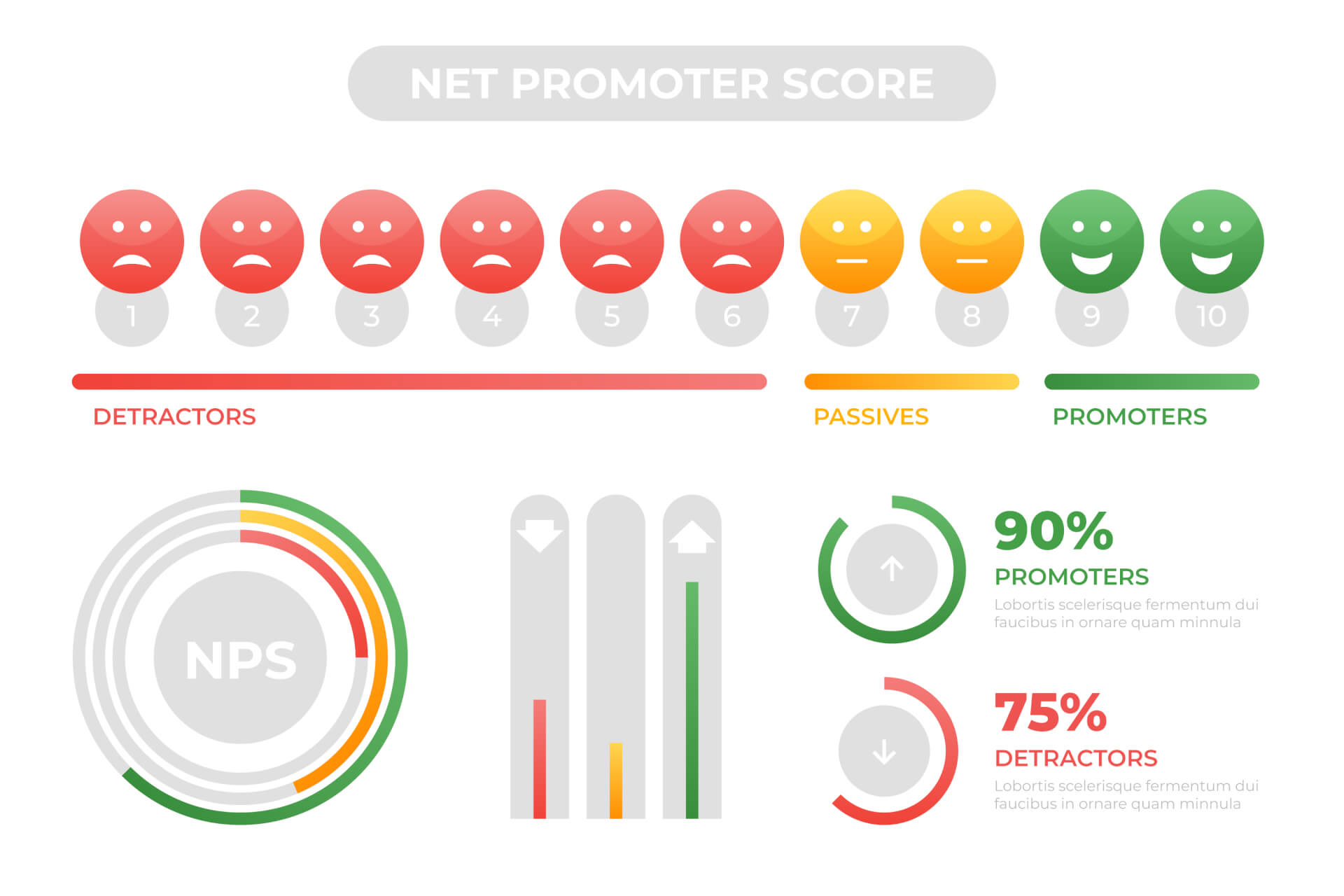The customer survey via Net Promoter Score® has the advantage over other forms of survey in that you receive relevant customer feedback promptly when you need it most.
The feedback received can be used to plan and implement changes and improvements to your product or service. Done correctly, chances are you're winning back an insecure customer who is already considering switching providers, or the long-term respect and loyalty of a valuable customer.
But when does feedback lose its relevance? Over time, your company and its customers are likely to change. Can you still rely on feedback from months or years ago to determine your customer satisfaction priorities? Should you let it affect your Net Promoter Score as well?
 The following describes how you should respond to feedback from your customers not only in the short term but also in the long term. We also clarify here when you can safely delete or even ignore feedback from your customers.
The following describes how you should respond to feedback from your customers not only in the short term but also in the long term. We also clarify here when you can safely delete or even ignore feedback from your customers.
Table of Contents
- To get the most out of NPS, act as soon as possible
- After closing the customer feedback loop, ignore stale responses
- Maintain feedback on the bigger picture to encourage long-term change
- Can the customer's problem still be resolved?
- Risks to be aware of if you delete or ignore NPS responses
- Manage your NPS feedback with Callexa
To get the most out of NPS, act as soon as possible
 Simplicity is often cited as the greatest strength of the Net Promoter Score, after all it is a short survey that works mainly because it is simple - an advantage that longer, more detailed surveys cannot keep up with.
Simplicity is often cited as the greatest strength of the Net Promoter Score, after all it is a short survey that works mainly because it is simple - an advantage that longer, more detailed surveys cannot keep up with.
A less noticed but equally great strength of an NPS® survey is the speed with which you can collect feedback from your users and customers.
Compared to traditional email or web-based surveys, which are designed to measure satisfaction and sentiment in a macro-economic sense, the Net Promoter Score can be used to track the response to a very timely, short-term event. For example, when you use an NPS tool like Callexa to survey your customers about new additions or enhancements to your product, a new feature, or a recent upgrade.
Because NPS is designed to provide quick, meaningful feedback, it isn't difficult to get your customers' opinion on a specific change or improvement.
This leads to an important aspect in the effective use of the Net Promoter Score:
When using NPS to generate short-term, highly relevant feedback, you need to act quickly to get the full benefit from your customers' responses.
This type of feedback has enormous short-term value, but it has a short half-life and can "expire" quickly. So act quickly and get real improvements while the customer is fresh on the topic, rather than weeks or months later when interest has waned and the customer may no longer be interested in the topic.

Reading recommendation: There is no such thing as too much feedback. Therefore, always make sure to optimize response rates. Our blog article deals with “The importance of the memory survey”
After closing the customer feedback loop, ignore stale responses
 If you get feedback from a passive or reviewer with specific advice on how to improve your product or service, start implementing it as soon as possible to close the customer feedback loop.
If you get feedback from a passive or reviewer with specific advice on how to improve your product or service, start implementing it as soon as possible to close the customer feedback loop.
Then, if you have successfully implemented the feedback, recommendations, or suggestion for improvement and informed the customer (and thus closed the customer feedback loop), ignore that feedback from your global NPS score.
Ignoring a certain NPS score from a review sounds like falsifying the results at first, but in reality you are updating the current NPS score.
Because if you judge your company on the basis of customer feedback that you have already responded to and have already resolved, you will only receive a falsified value that does not reflect the current mood of your customers.
Of course, the historical answers of your customers are also important later, for example to be able to see directly whether the satisfaction of a customer has increased or unfortunately decreased.
Callexa offers you the option to mark a score as ignored. It is then no longer taken into account when calculating the NPS value. However, the rating remains in the system and can still be viewed in the customer's history.
Likewise, deleting or ignoring a review is an important step in your micro-customer relationships. After you've solved the problem and promoted the reviewer for your product or service, there is no need to use their old rating as a measure of their mood.
Important: This only works if you remember to close the customer feedback loop before removing a customer review from your overall NPS. Failure to consider real feedback before you have a chance to act will skew your Net Promoter Score.
Maintain feedback on the bigger picture to encourage long-term change
 Customer feedback can often be divided into two categories. There is short-term feedback that discusses specific features, problems, and malfunctions, many of which can usually be resolved quickly.
Customer feedback can often be divided into two categories. There is short-term feedback that discusses specific features, problems, and malfunctions, many of which can usually be resolved quickly.
However, there is also feedback on problems or suggestions for improvement that can only be implemented in weeks or even months.
This type of feedback is more difficult to respond to than short-term feedback, simply because you can't close the customer feedback loop in a day or two.
However, this type of feedback can often be the most valuable feedback to help you point the right direction for real and permanent changes / improvements to your product, service or company.
When you receive extensive feedback from a customer - for example, a message about an additional feature that you might implement, or a complete redesign of your user interface to resolve usability issues - it is never wise to ignore it too soon.
Instead, keep an eye on it so you always know the feedback and are ready to take action to resolve it.
Only after you have successfully closed the customer feedback loop should you consider removing this rating from your NPS score. Callexa allows you to sort customer feedback so it is easier to filter the feedback and close the feedback loop with all responses from the same category.
Can the customer's problem still be resolved?
If you want to verify that a customer's feedback still belongs on your NPS dashboard, then ask yourself if there is still a solution to this problem.
- If so, when can this be implemented or has it already been done?
- Once you've resolved the problem, it's time to update it in your current NPS score.
As your customer base grows, you inevitably receive feedback that is irrelevant the moment you receive it. This type of feedback often comes from inactive customers who have not used your product for a long time due to a bug that has since been fixed without their knowledge.
If so, close the customer feedback loop by telling that customer that their problem has already been resolved and advising them of the solution.
 After you've closed the customer feedback loop, discard their feedback - it's not fair to your company to allow out of date feedback to affect your current Net Promoter Score. Instead, send them another survey and see how their satisfaction has changed.
After you've closed the customer feedback loop, discard their feedback - it's not fair to your company to allow out of date feedback to affect your current Net Promoter Score. Instead, send them another survey and see how their satisfaction has changed.
Then there is also the scenario where a customer gave you a critical review and left before you implemented a fix or solution to their problem.
Technically, you have closed the feedback loop and your customers should be more satisfied. In reality, the customer who has left the company does not receive any further questioning and thus has no opportunity to re-submit his rating based on satisfaction.
Therefore, always make sure to respond quickly to feedback and let critics know that you are working on a solution if the problem cannot be resolved immediately. If the reviewer realizes that their feedback is important to you, the time to churn is delayed, which allows you to fix the problem before you lose the customer.
Risks to be aware of if you delete or ignore NPS responses
Now that you know the characteristics of when an NPS response expires and is no longer relevant, another question naturally arises:
What are the risks of ignoring NPS responses?
Deleting your customers' responses entirely is not a good idea unless they are test results and feedback that you yourself provided while learning about an NPS product.
Even a score that seems irrelevant at the beginning can still indicate a problem that you should be aware of. For example, if you get a low score from customers and are told when asked about it, that the respondent doesn't even know why they received the survey.
 In this case, it is most likely that these customers tried your product a long time ago and have since forgotten it. This is a sign that you need to review the customer base and remove inactive customers who should not receive a recurring survey.
In this case, it is most likely that these customers tried your product a long time ago and have since forgotten it. This is a sign that you need to review the customer base and remove inactive customers who should not receive a recurring survey.
Other customers give you a bad score saying that they signed up by mistake because they think your company has the solution they were looking for. In theory, this answer is irrelevant.
In practice, however, this means that the information about your product or service may confuse or misinform potential new customers, so you may want to customize it.
How to deal with feedback from users who received a survey because of incorrect logins was discussed in the article "Should you consider the results of erroneous applications in your NPS?"
However, the best argument against deleting irrelevant responses is that you lose customer historical data. We have already established that the NPS score is less important than the dynamics of the score; whether it grows or falls is critical in assessing customer satisfaction over time.
For this reason, it's best to ignore an NPS response and make sure you can add it back to the NPS historical data whenever you need to.
Manage your NPS feedback with Callexa
Callexa makes it easy to survey your customers and get actionable, valuable feedback with the Net Promoter Score. You can manually ignore irrelevant answers in order to get an up-to-date customer satisfaction level without losing the historical data of the respective customer.
Try it out and create your free Callexa account here, with which you can send 50 surveys per month to your customers for free.
 Reading recommendation: If this article helped you and you would like to find out more about the Net Promoter Score, continue reading here: “The Net Promoter Score – Basics and Areas of Application”
Reading recommendation: If this article helped you and you would like to find out more about the Net Promoter Score, continue reading here: “The Net Promoter Score – Basics and Areas of Application”